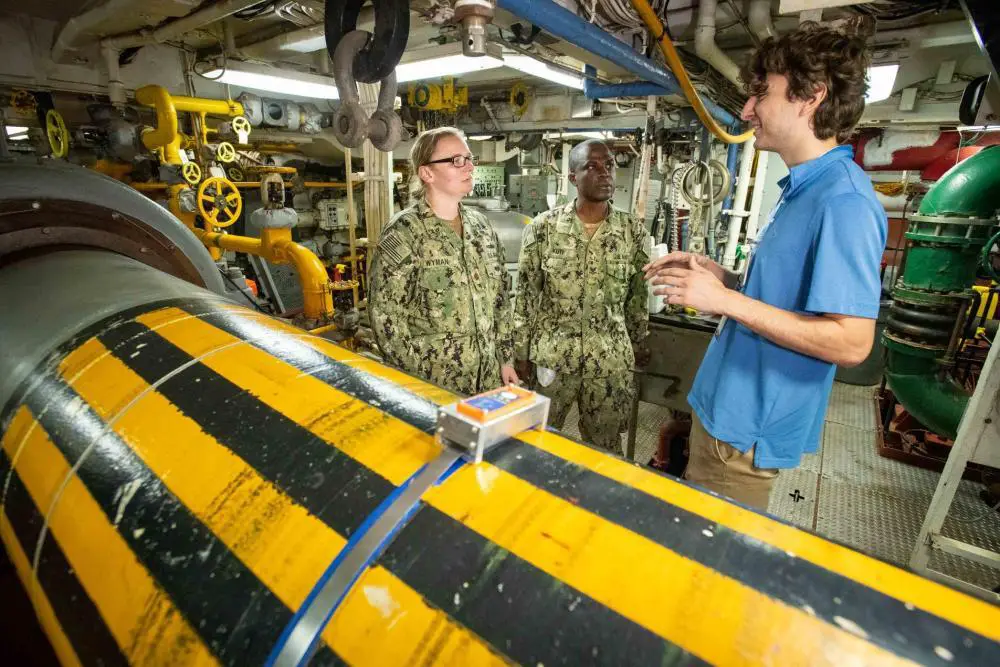A variety of robots crawling in, on and below a decommissioned U.S. Navy destroyer, as well as replacement parts being additively manufactured on site, comprised just a small part of the activity that took place during the first-ever U.S. Navy Repair Technology Exercise, or REPTX, held Aug. 22-Sept. 1 at Naval Base Ventura County (NBVC) in Ventura County, California. Teams from various companies as well as academic and government laboratories arrived from around the world with their technology applications to conduct demonstrations and field experiments aboard the decommissioned Spruance-class destroyer, known as the Self Defense Test Ship (SDTS). The ship is operated by personnel from Naval Surface Warfare Center, Port Hueneme Division (NSWC PHD) in Port Hueneme, California, a field activity of Naval Sea Systems Command (NAVSEA) and located at NBVC. NAVSEA’s Naval Systems Engineering and Logistics Directorate Technology Office (NAVSEA 05T) sponsored REPTX 2022, which was hosted by NSWC PHD and held both pierside and aboard the SDTS, which took to the sea for the second week of the event.
“Our priorities as a warfare center are to deliver and sustain readiness, modernize and maintain the current fleet, and field the surface fleet of the future,” said Capt. Andrew Hoffman, NSWC PHD commanding officer. “REPTX demonstrates these priorities by allowing both industry, government and academia to work side-by-side while exploring innovative maintenance concepts that we can rapidly deliver to our forward-deployed warfighters.”
“The format provides a realistic fielding environment, both pierside and underway, allowing teams the chance to field, adjust, learn and retest their solutions,” said Janice Bryant, sustainment technology program manager at NAVSEA 05T.
“REPTX didn’t just showcase technology but applied it to solve Navy challenges,” Bryant added. “It was a problem-centric event that promoted collaboration rather than competition. Many problems require a complex solution, and multiple participants have independent pieces of that solution.”

The purpose of the inaugural exercise was to see if the technology can tackle real-world fleet maintenance and battle-damage related repairs of ships while operating in a true maritime environment — boosting the Navy’s ability to keep ships at sea by aiding sailors in carrying out needed repairs. The more than 60 REPTX participants demonstrated technologies designed to address four focus areas: visualization, command and control aids, forward manufacturing and expeditionary maintenance. The technology also needed to be capable of taking on a “day job” — in other words, serving a purpose that adds value to Navy ships and crew on a routine basis. And, it has to be user-friendly enough for a ship’s crew to learn quickly. Approximately 20 reservists from the Navy’s Surge Maintenance (SurgeMain) program provided that ship’s crew perspective as they got hands-on with much of the technology, learning how to operate the remote-controlled robotics, wearing augmented reality (AR) headsets to view repair instructions and videos, measuring corrosion on the deckplate of the SDTS, and more.
Scenarios where reservists were able to remotely control robots included identifying unknown objects on the side of the ship’s hull, detangling a fouled propeller, measuring the depth of metal wastage due to corrosion using ultrasonic waves, and inspecting tight spaces that would be difficult or dangerous for a human to go into. Several companies brought AR technology to the SDTS, providing both communication and real-time visuals during simulated battle damage assessment scenarios as well as repair work instructions and videos that can be viewed through the headset while simultaneously looking at the damaged area. Additive manufacturing technology installed in compact shipping containers both pierside and aboard the SDTS provided the capability to 3D print replacement parts as needed in a variety of materials. Other scenarios involved ship-to-shore communication systems, inspection and repair tools, and above- and below-water visualization devices.

Technology suppliers assisted SurgeMain reservists in using and demonstrating the technology aboard the SDTS during week two — this time in a true maritime environment as the vessel went underway off the coast of Port Hueneme. Unmanned aerial vehicle (UAV) operators got a chance to fly their camera-equipped drones around the ship to inspect it. The main goals of the UAV demonstrations during REPTX were to identify issues like corrosion and misplaced items and to test the UAVs’ capabilities to aid in battle damage assessment and repair — a key focus area for the Navy — by rapidly creating digital models, among other things. In one scenario, a flange with a leaky gasket was the focus of a collaborative effort on the last underway day of REPTX. The SDTS crew had identified the issue in the ship’s state room, and several technology suppliers worked on a fix with SurgeMain sailors. A reservist used an AR headset during the scenario to connect remotely with a subject matter expert elsewhere to help inspect and measure the faulty flange.
Armed with measurements of the flange assembly, two additive manufacturing companies participating in REPTX later 3D-printed parts that could be used to replace the flange and gasket in the state room. Other underway demonstrations tested, repaired and monitored vital equipment on the ship. Participants and organizers agreed that some of the best things to come out of REPTX were the spontaneous collaborations between attending organizations that revealed more efficient uses of their individual technologies when used together. Along with the focus on collaboration, organizers designed the event to be educational for everyone involved. The learning experience was impactful in that it was hands on, operationally based and held aboard an active ship. Bryant said that next steps include determining how to invest $2 million in follow-on funding to further develop technologies for fielding in the fleet. The REPTX team will also release to the public a comprehensive after action report on the event.












